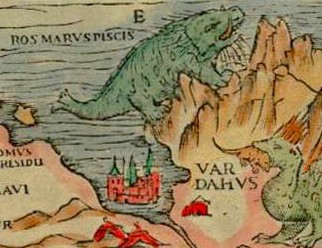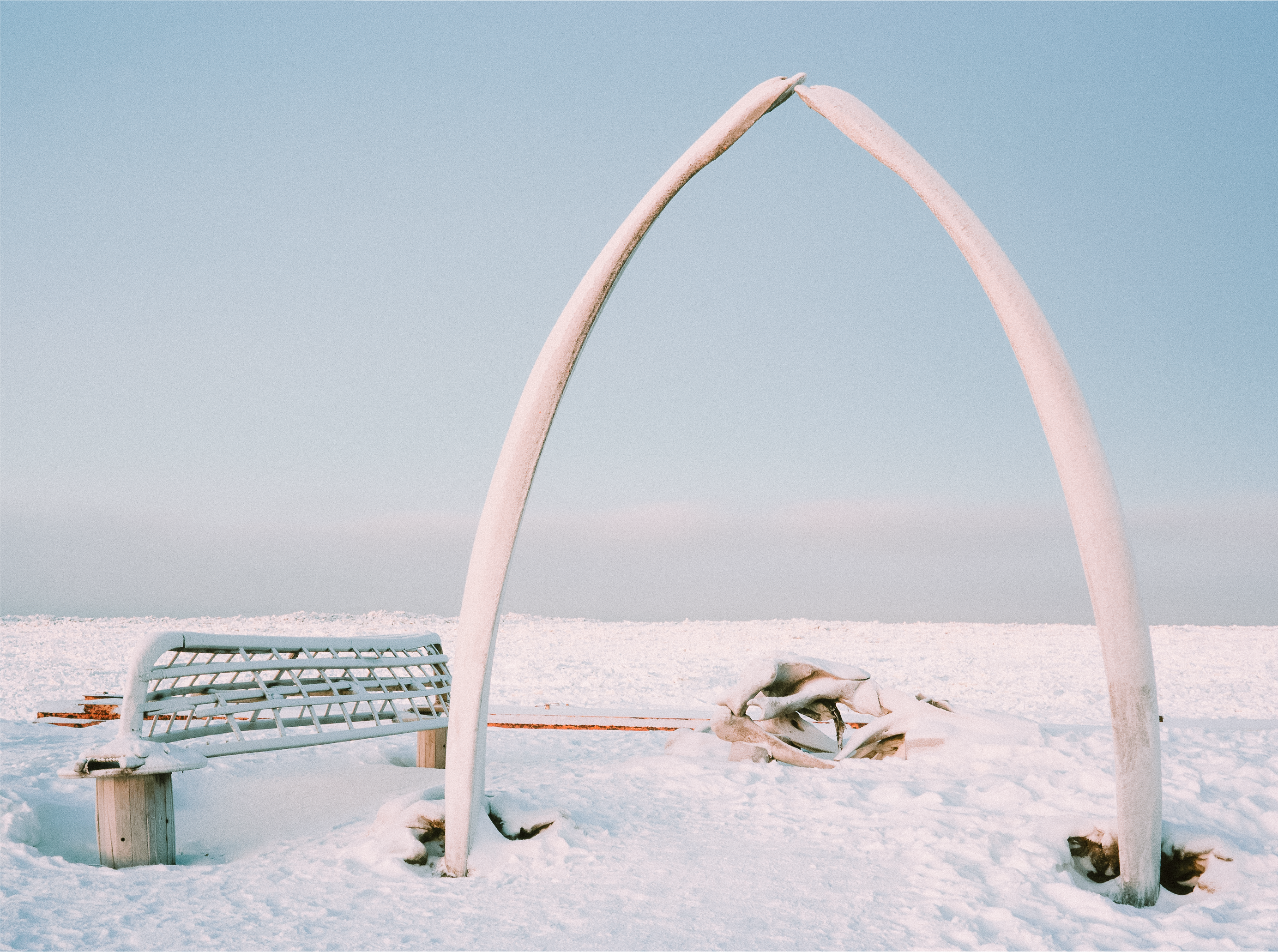|
Chukchi Sea Shelf
The Chukchi Shelf or Chukchi Sea Shelf is the westernmost part of the continental shelf of the United States and the easternmost part of the continental shelf of Russia. In the west it merges with the Russian Siberian Shelf. Within this shelf, the 50-mile Chukchi Corridor acts as a passageway for one of the largest marine mammal migrations in the world. The main geological features of the Chukchi Shelf are the Hope Basin and the Herald Thrust, a basement uplift cored by Cretaceous thrust faults. The latter is named after Herald Island. Off the northwestern Alaskan coast there is a Jurassic rift basin, the Hannah Trough. To the north of Alaska the Chukchi Shelf extends to form the Chukchi Plateau which protrudes into the Arctic Ocean geological zone. The Chukchi Shelf is shared between Russia and the United States according to the June 1990 USSR–USA Maritime Boundary Agreement. 50-Mile Chukchi Corridor The Chukchi Corridor is a 50-mile wide strip of ocean offshore of Nor ... [...More Info...] [...Related Items...] OR: [Wikipedia] [Google] [Baidu] |
Arctic Ocean Bathymetric Features
The Arctic (; . ) is the polar regions of Earth, polar region of Earth that surrounds the North Pole, lying within the Arctic Circle. The Arctic region, from the IERS Reference Meridian travelling east, consists of parts of northern Norway (Nordland, Troms, Finnmark, Svalbard and Jan Mayen), northernmost Sweden (Västerbotten, Norrbotten and Lapland (Sweden), Lappland), northern Finland (North Ostrobothnia, Kainuu and Lapland (Finland), Lappi), Russia (Murmansk Oblast, Murmansk, Siberia, Nenets Autonomous Okrug, Nenets Okrug, Novaya Zemlya), the United States (Alaska), Canada (Yukon, Northwest Territories, Nunavut), Danish Realm (Greenland), and northern Iceland (Grímsey and Kolbeinsey), along with the Arctic Ocean and adjacent seas. Land within the Arctic region has seasonally varying cryosphere, snow and ice cover, with predominantly treeless permafrost under the tundra. Arctic seas contain seasonal sea ice in many places. The Arctic region is a unique area among Earth's ... [...More Info...] [...Related Items...] OR: [Wikipedia] [Google] [Baidu] |
Pacific Walrus
The walrus (''Odobenus rosmarus'') is a large pinniped marine mammal with discontinuous distribution about the North Pole in the Arctic Ocean and subarctic seas of the Northern Hemisphere. It is the only extant species in the family Odobenidae and genus ''Odobenus''. This species is subdivided into two subspecies: the Atlantic walrus (''O. r. rosmarus''), which lives in the Atlantic Ocean, and the Pacific walrus (''O. r. divergens''), which lives in the Pacific Ocean. Adult walrus are characterised by prominent tusks and whiskers, and considerable bulk: adult males in the Pacific can weigh more than and, among pinnipeds, are exceeded in size only by the two species of elephant seals. Walrus live mostly in shallow waters above the continental shelves, spending significant amounts of their lives on the sea ice looking for benthic bivalve molluscs. Walruses are relatively long-lived, social animals, and are considered to be a "keystone species" in the Arctic marine regions. The ... [...More Info...] [...Related Items...] OR: [Wikipedia] [Google] [Baidu] |
Spectacled Eider
The spectacled eider (pronounced ) (''Somateria fischeri'') is a large sea duck that breeds on the coasts of Alaska and northeastern Siberia. The spectacled eider is slightly smaller than the common eider at in length. The male is unmistakable with its black body, white back, and yellow-green head with the large circular white eye patches which give the species its name. The drake's call is a weak crooning, and the female's a harsh croak. The female is a rich brown bird, but can still be readily distinguished from all ducks except other eider species on size and structure. The paler goggles are visible with a reasonable view and clinch identification. Immature birds and eclipse adult drakes are similar to the female. The binomial commemorates the German scientist Johann Fischer von Waldheim Gotthelf Fischer von Waldheim (; 13 October 1771 – 18 October 1853) was a Electorate of Saxony, Saxon anatomist, entomologist and paleontologist. Fischer was born as Gotthilf Fisc ... [...More Info...] [...Related Items...] OR: [Wikipedia] [Google] [Baidu] |
National Marine Fisheries Service
The National Marine Fisheries Service (NMFS), informally known as NOAA Fisheries, is a United States federal agency within the U.S. Department of Commerce's National Oceanic and Atmospheric Administration (NOAA) that is responsible for the stewardship of U.S. national marine resources. It conserves and manages fisheries to promote sustainability and prevent lost economic potential associated with overfishing, declining species, and degraded habitats. History Founded in 1871 as the U.S. Commission of Fish and Fisheries, the National Marine Fisheries Service is the oldest federal conservation and environmental research agency in the United States. The commission was formed when President Ulysses S. Grant named zoologist Spencer Fullerton Baird, United States National Museum director and assistant secretary of the Smithsonian Institution, the first commissioner of the United States Fish Commission. The commission was divided into three research categories: the study of U.S. ... [...More Info...] [...Related Items...] OR: [Wikipedia] [Google] [Baidu] |
Utqiagvik, Alaska
Utqiagvik ( ; , ), formerly known as Barrow ( ), is the borough seat and largest city of the North Slope Borough in the U.S. state of Alaska. Located north of the Arctic Circle, it is one of the northernmost cities and towns in the world and the northernmost in the United States, with nearby Point Barrow as the country's northernmost point. Utqiaġvik's population was 4,927 at the 2020 census, an increase from 4,212 in 2010. It is the 12th-most populated city in Alaska. Name The location has been home to the Iñupiat, an indigenous Inuit ethnic group, for more than 1,500 years. The city's Iñupiaq name refers to a place for gathering wild roots. It is derived from the Iñupiat word , also used for '' Claytonia tuberosa'' (" Eskimo potato"). The name was first recorded by European explorers in 1853 as "Ot-ki-a-wing" by Commander Rochfort Maguire, Royal Navy. John Simpson's native map dated 1855 has the name "Otkiawik", which was later misprinted on a British Admiralty char ... [...More Info...] [...Related Items...] OR: [Wikipedia] [Google] [Baidu] |
Wainwright, Alaska
Wainwright (; ''Ulġuniq'' in Iñupiaq), also known as Ulguniq or Kuuk, is a city in North Slope Borough, Alaska, United States. At the 2020 census the population was 628, making it the third largest city in the North Slope Borough, up from 556 in 2010. The community was named after Wainwright Lagoon, which in turn was named after Lt. John Wainwright, an officer under Capt. F. W. Beechey, who were the first non-native people to travel to the lagoon in 1826. An unincorporated area known as Wainwright Inlet by 1890, Wainwright was founded as an incorporated municipality in 1904. Geography and climate Wainwright is located on the Chukchi Sea about southwest of Utqiaġvik. According to the United States Census Bureau, the city has a total area of , of which, of it is land and of it (58.63%) is water. Wainwright has a dry-winter Arctic climate (Köppen ETw) with temperatures ranging from . There is little precipitation, mostly snow; however, the dry winters make the annual sn ... [...More Info...] [...Related Items...] OR: [Wikipedia] [Google] [Baidu] |
Point Lay, Alaska
Point Lay (''Kali ''in Inupiaq- "Mound") is a census-designated place (CDP) in North Slope Borough, Alaska, United States. At the 2020 census the population was 330, up from 189 in 2010. Geography and climate Point Lay is located on the shores of the Chukchi Sea. According to the United States Census Bureau, the CDP has a total area of , of which, of it is land and of it (11.66%) is water. Point Lay once was on a barrier island of Kasegaluk Lagoon, but moved to the mainland near the mouth of the Kokolik River during the 1970s. A weather station was operated from October 1949 to March 1958. Apart from its landmass that is in mainland Alaska, it also consists two peninsulas that are found on its most northwestern side. Point Lay has a tundra climate (Koppen ET) with long, very cold winters and short, cool to mild summers. Demographics Point Lay first appeared on the 1880 U.S. Census as an unincorporated Inuit village. All 30 of its residents were Inuit. It returned ag ... [...More Info...] [...Related Items...] OR: [Wikipedia] [Google] [Baidu] |
Point Hope, Alaska
Point Hope (, ) is a city in North Slope Borough, Alaska, United States. At the 2010 census the population was 674, down from 757 in 2000. In the 2020 Census, the population rose to 830. Like many isolated communities in Alaska, the city has no road or rail connections to the outside world, and must be accessed by sea or by air at Point Hope Airport. History Before any modern settlement, the Ipiutak lived here. The descriptive Inuit name of the place, "Tikarakh" or " Tikiġaq", commonly spelled "Tiagara", means "forefinger". It was recorded as "Tiekagagmiut" in 1861 by P. Tikhmeniev Wich of the Russian Hydrographic Department and on Russian Chart 1495 it became "Tiekaga". This ancient village site was advantageous, because the protrusion of Point Hope into the sea brought the whales close to the shore. At Tikigaq, they built semi-subterranean houses using mainly whalebone and driftwood. Point Hope is one of the oldest continually occupied sites in North America. While s ... [...More Info...] [...Related Items...] OR: [Wikipedia] [Google] [Baidu] |
Saffron Cod
The saffron cod ''(Eleginus gracilis)'' is a commercially harvested fish closely related to true cods (genus ''Gadus''). It is dark grey-green to brown, with spots on its sides and pale towards the belly. It may grow to 55 cm and weigh up to 1.3 kg. Its range spans the North Pacific, from Yellow Sea, the Yellow Sea and the Sea of Okhotsk in the west to the northern Gulf of Alaska and Sitka, Alaska, in the east. It also occurs in the Chukchi Sea (Arctic Ocean). It normally occurs in shallow coastal waters at less than 60 m depth but may also be found at depths up to 200 m. The saffron cod may also enter brackish and even fresh waters, occurring quite far up rivers and streams, but remaining within regions of tidal influence. Saffron cods begin to mature during their third year of life. They feed on fish and small crustaceans. They are commercially fished in many areas of the northwestern Pacific. The country with the largest catch is Russia. It is used for human consumpt ... [...More Info...] [...Related Items...] OR: [Wikipedia] [Google] [Baidu] |
Arctic Cod
''Arctogadus glacialis'', known also with ambiguous common names Arctic cod and polar cod, is an Arctic species of fish in the cod Family (biology), family Gadidae, related to the true Gadus, cod (genus ''Gadus''). ''Arctogadus glacialis'' is found in icy water. They grow to about 30 cm long, and are favorite food of narwhals and other arctic whales. Common names and taxonomy The common names "Arctic cod" and "polar cod" can refer to either ''Arctogadus glacialis'' or ''Boreogadus saida'', and "Arctic cod" may also refer to ''Eleginus nawaga''. Another Arctic gadid, the East Siberian cod (''Arctogadus borisovi''), was until recently considered the closest relative of ''A. glacialis''. It has, however, been found not to be distinct from ''A. glacialis'', and should be included in this species. According to this result, ''Arctogadus'' is a monotypic genus. However, ''Arctogadus'' is a close relative of ''Boreogadus saida, Boreogadus'', and should perhaps be included in that g ... [...More Info...] [...Related Items...] OR: [Wikipedia] [Google] [Baidu] |





